Qing Zhao
School of Physics, Beijing Institute of Technology, China, Beijing Academy of Quantum Information Sciences, China
ADNP-15: An Open-Source Histopathological Dataset for Neuritic Plaque Segmentation in Human Brain Whole Slide Images with Frequency Domain Image Enhancement for Stain Normalization
May 08, 2025Abstract:Alzheimer's Disease (AD) is a neurodegenerative disorder characterized by amyloid-beta plaques and tau neurofibrillary tangles, which serve as key histopathological features. The identification and segmentation of these lesions are crucial for understanding AD progression but remain challenging due to the lack of large-scale annotated datasets and the impact of staining variations on automated image analysis. Deep learning has emerged as a powerful tool for pathology image segmentation; however, model performance is significantly influenced by variations in staining characteristics, necessitating effective stain normalization and enhancement techniques. In this study, we address these challenges by introducing an open-source dataset (ADNP-15) of neuritic plaques (i.e., amyloid deposits combined with a crown of dystrophic tau-positive neurites) in human brain whole slide images. We establish a comprehensive benchmark by evaluating five widely adopted deep learning models across four stain normalization techniques, providing deeper insights into their influence on neuritic plaque segmentation. Additionally, we propose a novel image enhancement method that improves segmentation accuracy, particularly in complex tissue structures, by enhancing structural details and mitigating staining inconsistencies. Our experimental results demonstrate that this enhancement strategy significantly boosts model generalization and segmentation accuracy. All datasets and code are open-source, ensuring transparency and reproducibility while enabling further advancements in the field.
Bridging Cognition and Emotion: Empathy-Driven Multimodal Misinformation Detection
Apr 24, 2025Abstract:In the digital era, social media has become a major conduit for information dissemination, yet it also facilitates the rapid spread of misinformation. Traditional misinformation detection methods primarily focus on surface-level features, overlooking the crucial roles of human empathy in the propagation process. To address this gap, we propose the Dual-Aspect Empathy Framework (DAE), which integrates cognitive and emotional empathy to analyze misinformation from both the creator and reader perspectives. By examining creators' cognitive strategies and emotional appeals, as well as simulating readers' cognitive judgments and emotional responses using Large Language Models (LLMs), DAE offers a more comprehensive and human-centric approach to misinformation detection. Moreover, we further introduce an empathy-aware filtering mechanism to enhance response authenticity and diversity. Experimental results on benchmark datasets demonstrate that DAE outperforms existing methods, providing a novel paradigm for multimodal misinformation detection.
Performance Estimation for Supervised Medical Image Segmentation Models on Unlabeled Data Using UniverSeg
Apr 22, 2025Abstract:The performance of medical image segmentation models is usually evaluated using metrics like the Dice score and Hausdorff distance, which compare predicted masks to ground truth annotations. However, when applying the model to unseen data, such as in clinical settings, it is often impractical to annotate all the data, making the model's performance uncertain. To address this challenge, we propose the Segmentation Performance Evaluator (SPE), a framework for estimating segmentation models' performance on unlabeled data. This framework is adaptable to various evaluation metrics and model architectures. Experiments on six publicly available datasets across six evaluation metrics including pixel-based metrics such as Dice score and distance-based metrics like HD95, demonstrated the versatility and effectiveness of our approach, achieving a high correlation (0.956$\pm$0.046) and low MAE (0.025$\pm$0.019) compare with real Dice score on the independent test set. These results highlight its ability to reliably estimate model performance without requiring annotations. The SPE framework integrates seamlessly into any model training process without adding training overhead, enabling performance estimation and facilitating the real-world application of medical image segmentation algorithms. The source code is publicly available
Component-aware Unsupervised Logical Anomaly Generation for Industrial Anomaly Detection
Feb 17, 2025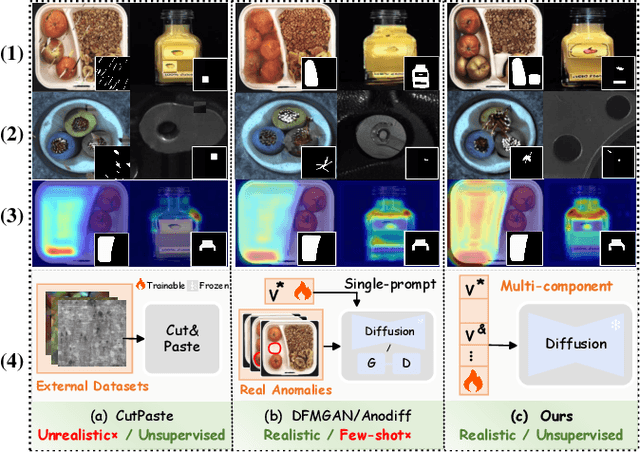
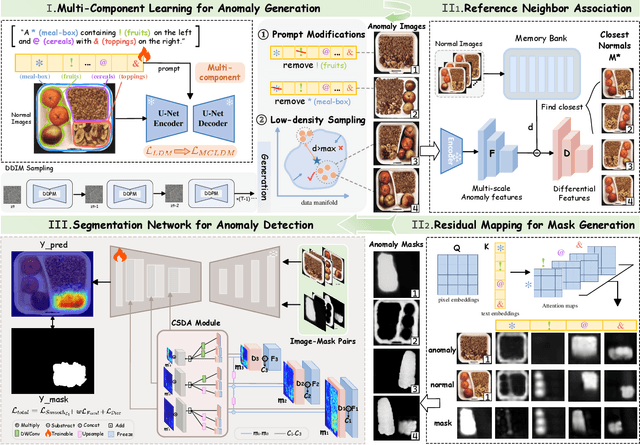

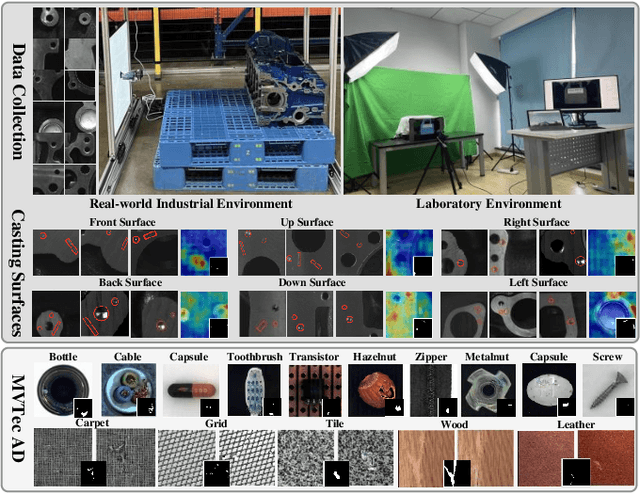
Abstract:Anomaly detection is critical in industrial manufacturing for ensuring product quality and improving efficiency in automated processes. The scarcity of anomalous samples limits traditional detection methods, making anomaly generation essential for expanding the data repository. However, recent generative models often produce unrealistic anomalies increasing false positives, or require real-world anomaly samples for training. In this work, we treat anomaly generation as a compositional problem and propose ComGEN, a component-aware and unsupervised framework that addresses the gap in logical anomaly generation. Our method comprises a multi-component learning strategy to disentangle visual components, followed by subsequent generation editing procedures. Disentangled text-to-component pairs, revealing intrinsic logical constraints, conduct attention-guided residual mapping and model training with iteratively matched references across multiple scales. Experiments on the MVTecLOCO dataset confirm the efficacy of ComGEN, achieving the best AUROC score of 91.2%. Additional experiments on the real-world scenario of Diesel Engine and widely-used MVTecAD dataset demonstrate significant performance improvements when integrating simulated anomalies generated by ComGEN into automated production workflows.
Comparative Analysis of Pre-trained Deep Learning Models and DINOv2 for Cushing's Syndrome Diagnosis in Facial Analysis
Jan 21, 2025



Abstract:Cushing's syndrome is a condition caused by excessive glucocorticoid secretion from the adrenal cortex, often manifesting with moon facies and plethora, making facial data crucial for diagnosis. Previous studies have used pre-trained convolutional neural networks (CNNs) for diagnosing Cushing's syndrome using frontal facial images. However, CNNs are better at capturing local features, while Cushing's syndrome often presents with global facial features. Transformer-based models like ViT and SWIN, which utilize self-attention mechanisms, can better capture long-range dependencies and global features. Recently, DINOv2, a foundation model based on visual Transformers, has gained interest. This study compares the performance of various pre-trained models, including CNNs, Transformer-based models, and DINOv2, in diagnosing Cushing's syndrome. We also analyze gender bias and the impact of freezing mechanisms on DINOv2. Our results show that Transformer-based models and DINOv2 outperformed CNNs, with ViT achieving the highest F1 score of 85.74%. Both the pre-trained model and DINOv2 had higher accuracy for female samples. DINOv2 also showed improved performance when freezing parameters. In conclusion, Transformer-based models and DINOv2 are effective for Cushing's syndrome classification.
Deep Learning-Based Feature Fusion for Emotion Analysis and Suicide Risk Differentiation in Chinese Psychological Support Hotlines
Jan 15, 2025



Abstract:Mental health is a critical global public health issue, and psychological support hotlines play a pivotal role in providing mental health assistance and identifying suicide risks at an early stage. However, the emotional expressions conveyed during these calls remain underexplored in current research. This study introduces a method that combines pitch acoustic features with deep learning-based features to analyze and understand emotions expressed during hotline interactions. Using data from China's largest psychological support hotline, our method achieved an F1-score of 79.13% for negative binary emotion classification.Additionally, the proposed approach was validated on an open dataset for multi-class emotion classification,where it demonstrated better performance compared to the state-of-the-art methods. To explore its clinical relevance, we applied the model to analysis the frequency of negative emotions and the rate of emotional change in the conversation, comparing 46 subjects with suicidal behavior to those without. While the suicidal group exhibited more frequent emotional changes than the non-suicidal group, the difference was not statistically significant.Importantly, our findings suggest that emotional fluctuation intensity and frequency could serve as novel features for psychological assessment scales and suicide risk prediction.The proposed method provides valuable insights into emotional dynamics and has the potential to advance early intervention and improve suicide prevention strategies through integration with clinical tools and assessments The source code is publicly available at https://github.com/Sco-field/Speechemotionrecognition/tree/main.
Differentially Private Kernelized Contextual Bandits
Jan 13, 2025Abstract:We consider the problem of contextual kernel bandits with stochastic contexts, where the underlying reward function belongs to a known Reproducing Kernel Hilbert Space (RKHS). We study this problem under the additional constraint of joint differential privacy, where the agents needs to ensure that the sequence of query points is differentially private with respect to both the sequence of contexts and rewards. We propose a novel algorithm that improves upon the state of the art and achieves an error rate of $\mathcal{O}\left(\sqrt{\frac{\gamma_T}{T}} + \frac{\gamma_T}{T \varepsilon}\right)$ after $T$ queries for a large class of kernel families, where $\gamma_T$ represents the effective dimensionality of the kernel and $\varepsilon > 0$ is the privacy parameter. Our results are based on a novel estimator for the reward function that simultaneously enjoys high utility along with a low-sensitivity to observed rewards and contexts, which is crucial to obtain an order optimal learning performance with improved dependence on the privacy parameter.
Characterizing the Accuracy-Communication-Privacy Trade-off in Distributed Stochastic Convex Optimization
Jan 06, 2025Abstract:We consider the problem of differentially private stochastic convex optimization (DP-SCO) in a distributed setting with $M$ clients, where each of them has a local dataset of $N$ i.i.d. data samples from an underlying data distribution. The objective is to design an algorithm to minimize a convex population loss using a collaborative effort across $M$ clients, while ensuring the privacy of the local datasets. In this work, we investigate the accuracy-communication-privacy trade-off for this problem. We establish matching converse and achievability results using a novel lower bound and a new algorithm for distributed DP-SCO based on Vaidya's plane cutting method. Thus, our results provide a complete characterization of the accuracy-communication-privacy trade-off for DP-SCO in the distributed setting.
MentalGLM Series: Explainable Large Language Models for Mental Health Analysis on Chinese Social Media
Oct 14, 2024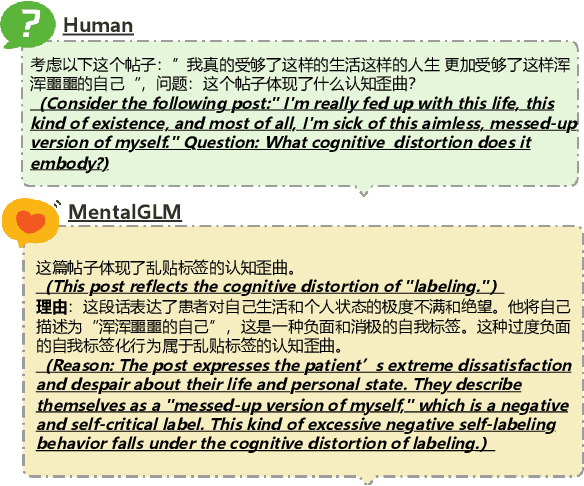

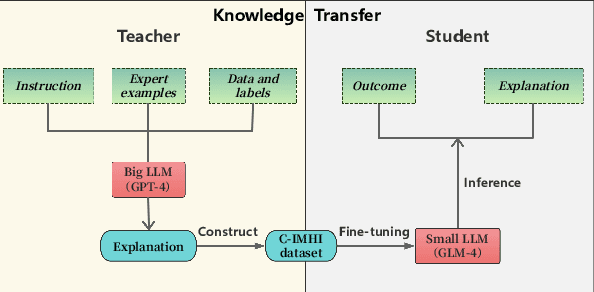

Abstract:As the prevalence of mental health challenges, social media has emerged as a key platform for individuals to express their emotions.Deep learning tends to be a promising solution for analyzing mental health on social media. However, black box models are often inflexible when switching between tasks, and their results typically lack explanations. With the rise of large language models (LLMs), their flexibility has introduced new approaches to the field. Also due to the generative nature, they can be prompted to explain decision-making processes. However, their performance on complex psychological analysis still lags behind deep learning. In this paper, we introduce the first multi-task Chinese Social Media Interpretable Mental Health Instructions (C-IMHI) dataset, consisting of 9K samples, which has been quality-controlled and manually validated. We also propose MentalGLM series models, the first open-source LLMs designed for explainable mental health analysis targeting Chinese social media, trained on a corpus of 50K instructions. The proposed models were evaluated on three downstream tasks and achieved better or comparable performance compared to deep learning models, generalized LLMs, and task fine-tuned LLMs. We validated a portion of the generated decision explanations with experts, showing promising results. We also evaluated the proposed models on a clinical dataset, where they outperformed other LLMs, indicating their potential applicability in the clinical field. Our models show strong performance, validated across tasks and perspectives. The decision explanations enhance usability and facilitate better understanding and practical application of the models. Both the constructed dataset and the models are publicly available via: https://github.com/zwzzzQAQ/MentalGLM.
Deep Learning and Large Language Models for Audio and Text Analysis in Predicting Suicidal Acts in Chinese Psychological Support Hotlines
Sep 10, 2024



Abstract:Suicide is a pressing global issue, demanding urgent and effective preventive interventions. Among the various strategies in place, psychological support hotlines had proved as a potent intervention method. Approximately two million people in China attempt suicide annually, with many individuals making multiple attempts. Prompt identification and intervention for high-risk individuals are crucial to preventing tragedies. With the rapid advancement of artificial intelligence (AI), especially the development of large-scale language models (LLMs), new technological tools have been introduced to the field of mental health. This study included 1284 subjects, and was designed to validate whether deep learning models and LLMs, using audio and transcribed text from support hotlines, can effectively predict suicide risk. We proposed a simple LLM-based pipeline that first summarizes transcribed text from approximately one hour of speech to extract key features, and then predict suicidial bahaviours in the future. We compared our LLM-based method with the traditional manual scale approach in a clinical setting and with five advanced deep learning models. Surprisingly, the proposed simple LLM pipeline achieved strong performance on a test set of 46 subjects, with an F1 score of 76\% when combined with manual scale rating. This is 7\% higher than the best speech-based deep learning models and represents a 27.82\% point improvement in F1 score compared to using the manual scale apporach alone. Our study explores new applications of LLMs and demonstrates their potential for future use in suicide prevention efforts.
 Add to Chrome
Add to Chrome Add to Firefox
Add to Firefox Add to Edge
Add to Edge